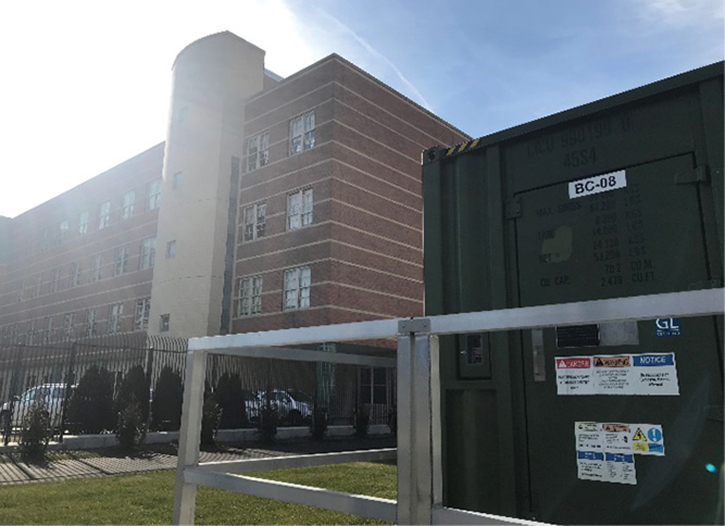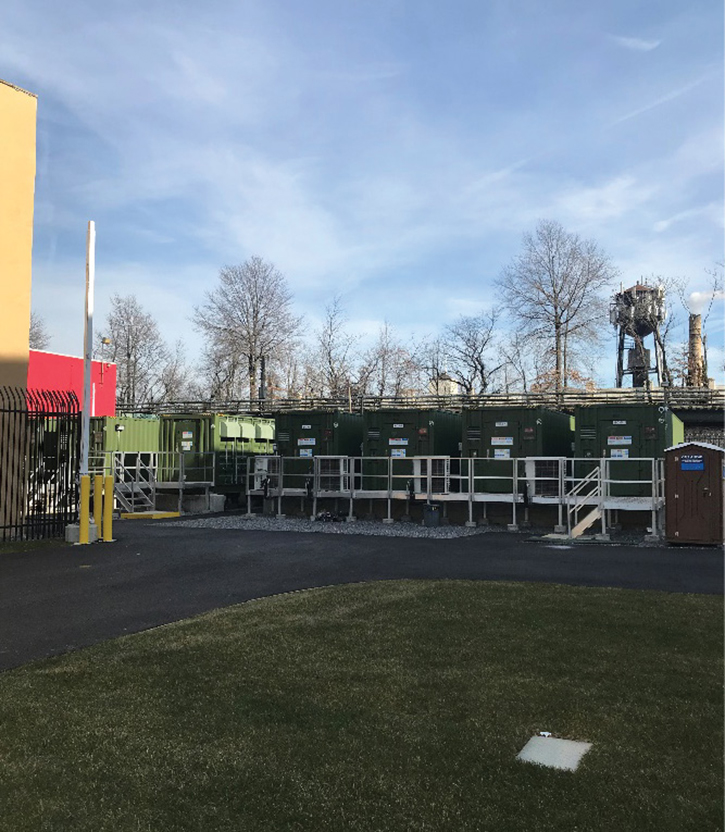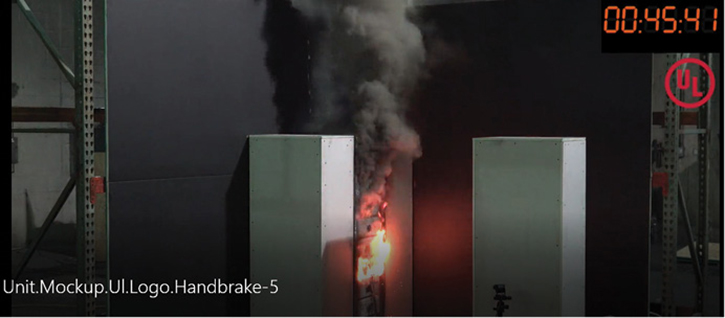
I (DeCrane) still remember the phone call almost four years ago from Lieutenant Paul Rogers of the Fire Department of New York (FDNY). At the time, I was representing the International Association of Fire Fighters (IAFF) in the building and fire code development processes and standards and he was assigned as a hazmat specialist for the FDNY Fire Prevention Bureau.
The FDNY was receiving an increasing number of permit submittals for the installation of energy storage systems (ESS). ESS are not new. New York City has thousands of buildings with uninterruptable power supplies (UPS) in place using lead-acid batteries. They provide power for a short duration during an outage. What is unique is the number of proposed ESS using lithium-ion batteries. ESS can be used more dynamically to deliver energy during peak hours; they are charged during off-peak hours.

(1) This New York City ESS is close to an elementary school. Are there exposure issues? (Photos by George Healy unless otherwise noted.)
Many factors contribute to this evolution and the advancement in ESS technology. Power outages that occurred during Hurricane Irene and Super Storm Sandy took emergency backup systems below ground offline. These events left numerous buildings and businesses with no reliable power, which ultimately led to interruption in business continuity. New York was also informed that the Indian Point nuclear power plant was losing its continuing operational license and the city could lose up to 30 percent of its power source. ESS are a critical component of the plan to replace the plant’s generation capacity with renewable energy sources.
RELATED FIREFIGHTER TRAINING
Responses to Energy Storage Systems
Ronald Spadafora: Firefighting in the Modern World: Sustainable Green Design and Construction
NFPA Introduces New Refrigerants Flammability and Toxicity Training
This migration toward renewable energy generation and storage and the interest of the building owners and managers to ensure business continuity by not allowing their emergency backup systems below grade to lose power have caused an increased interest in transitioning to using a lithium-ion based system, as it offers a high-density, low-footprint technology. These benefits are very important in these high-rent districts.
The attraction to lithium-ion ESS is easy to understand. If the building managers want to remove the risk of flooding, they need to install the ESS higher in the building. If building managers install them higher in the building, they will need to reduce the dedicated space because this cuts into the available leasable space. The challenge the FDNY was encountering was that fire and building codes and standards had not yet developed safety requirements applicable to the installation of lithium-ion batteries inside or outside of occupied buildings.

(2) Nearby occupancies and exposures need to be a major consideration when preplanning an ESS facility.
Code Requirements
We have made a great deal of progress since that day since committees were formed within the International Code Council (ICC) and the National Fire Protection Association (NFPA) to address provisions related to ESS, specifically electrochemical technologies, within the International Building, Fire, and Residential Codes. Underwriters Laboratories adopted Standard 9540A, Battery Energy Storage System (ESS) Test Method, developed to collect data on the fire and explosion hazards that can be used when designing appropriate fire mitigation strategies, and the NFPA adopted 855, Standard for the Installation of Stationary Energy Storage Systems. Both were developed through the hard work of industry representatives including members of the fire service.
The question is, however, “Are we there yet?” Within the fire service’s work environment, we can always argue that we will never “be there yet” because the work environment is constantly changing as new technologies, building materials, building systems, and fuel loads are constantly introduced. The main reason it is so important that the fire service be involved in codes and standards on the local, state, and national levels is that they must be involved with these evolutions as they come to market as opposed to playing catch-up after they are on the market.
Realizing the need to be vigilant and involved in these issues, FDNY Deputy Chief George Healy suggested we co-present a class on a recent ESS installation in his running district at the Fire Department Instructors Conference International. Recently, the local utility installed a dedicated outdoor ESS that uses lithium-ion batteries. Although the installation of this system is according to code, the location raises concerns. This installation is very close to an elementary school (photo 1).
The codes and standards committees realized the need for significant restrictions and requirements relative to the installation and use of electrochemical technology-based battery systems. Initially, conservative safety requirements based on small-scale testing were developed; but, as the research expanded, so did our understanding of the conditions of failures and hazards that could result. The results of these tests prompted additional modifications to the codes.

(3) A screen shot of a UL 9540A test demonstration for the International Association of Fire Fighters. (Photo courtesy of Underwriters Laboratories and the International Association of Fire Fighters.)
Everything Has a Failure Point
In the fire service, it is widely understood that everything has a failure point. It is important to understand where that fail point occurs and the potential results of the failure. This enables the industry to develop appropriate passive and active fire protection approaches and the fire service to plan its response accordingly. To accomplish this goal, we need reliable information based on product safety testing that is done to scale.
The 2018 edition of the International Code Council® (ICC) restricted the amount of energy permitted within a specific battery unit, separation space between the units, and the amount of energy permitted within a room. As with many items within our codes, there is an exception to permit a relief from these restrictions if the proponent can demonstrate compliance with full-scale testing. At that time, the challenge was that we did not have a standardized test for evaluating ESS fire and explosion safety performance.
This led to the development of UL 9540A, a standardized test methodology that uses a stepped procedure to evaluate the hazards that result if, and when, batteries experience a failure leading to thermal runaway. Thermal runaway is a condition typically experienced when a battery internally short circuits, generates heat faster than it can dissipate heat, and subsequently develops high pressures that can fail the containment and result in the release and potential ignition of gaseous by-products and electrolytes.

(4) A remote water supply will keep responders a safe distance from the fire/explosion site.
The dramatic increase in temperature may then stress surrounding cells, causing a potential propagation. UL 9540A evaluates whether the battery system design can contain these failures at the cell, module, and unit levels. This information is taken into consideration when designing protection and containment systems. UL 9540A tests also provide important information the fire service can incorporate into response plans. We are getting a solid understanding of the composition of the by-products. Many of the tests are measuring high levels of hydrogen and carbon monoxide. Although more work is ongoing, we have begun to understand that unless life safety is involved, the fire service needs to focus on potential exposures and isolating the incident.
Over the past couple of years, we have experienced failures in battery systems in Europe, Asia, and here in the United States. The fire service can prepare for these incidents and be proactive.
Moving Forward
Educate yourself on ESS. Educational materials are available on the IAFF (https://www.youtube.com/playlist?list=PLid8i4Cga6mBXiLlqE6c4YXYq193PiF8W) and NFPA (https://catalog.nfpa.org/Energy-Storage-and-Solar-Systems-Safety-Online-Training-P20882.aspx?icid=A647)Web sites. Build a relationship with your Building Department; learn when ESS are being installed in your jurisdiction and their locations. Become familiar with the protection system design and advocate for a remote water supply. Find out if these battery systems were tested to fire conditions, what test method was used, and what conditions you can expect in the event of a failure.
This is just a small bit of information regarding ESS for the fire service. A great deal of information will be available in the coming weeks; a full-scale testing schedule has been set and an incident review will be published later this spring.
The fire service’s work environment continues to change and develop at a rapid pace. It is our responsibility to keep up with these changes and to be involved in the testing, designing, installation, and maintenance processes.
SEAN DeCRANE retired as a battalion chief from the Cleveland (OH) Fire Department, where he was the acting chief of operations and director of training. DeCrane represented the International Association of Fire Fighters in the International Code Council® code development and the National Fire Protection Association standards processes. He is the business relations manager for UL’s Building and Life Safety Technologies Division.
GEORGE HEALY, a 28-year veteran of the Fire Department of New York, is deputy chief of development. His assignments have included the 13th Division, firefighter on Ladder 3 and Rescue 1, lieutenant on Ladder 174, captain of Division 14, and Special Operations Command. He was the chief at the Governor’s Island burn testing. He is a fire service instructor I and an instructor of the Battalion Chief Command course.

